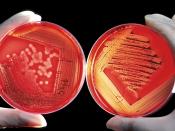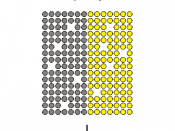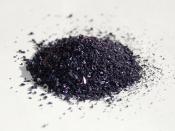Michael Akiboh
Biology 101 Non-Major
Diffusion through a Semi Solid
Introduction
This report will cover the Laboratory results of the experiment pertaining to diffusion in section five. The experiment was conducted in order to illustrate how the process of diffusion works. The experiment proves that diffusion which is the movement of molecules from areas of high concentration to areas of low concentration through a semi-permeable membrane is correct. In order to understand how diffusion through a semi-solid membrane works the following experiment was conducted. The process of diffusion has long been a staple in both the biological and physical sciences as such; the knowledge of this subject is extensive. Diffusion is the process whereby particles of liquids, gases, or solids intermingle as the result of their spontaneous movement caused by thermal agitation and in dissolved substances move from a region of higher to one of lower concentration. Osmosis is a process of absorption or diffusion suggestive of the flow of osmotic action.
The knowledge of this process occurring in solids and liquids is something that has been known since the birth of the sciences. In 1947, Ernest Kirkendall reported the results of experiments on the diffusion between copper and zinc in brass and observed the movement of the interface between the different phases due to high-temperature diffusion, now called the Kirkendall Effect. This phenomenon supported the idea that atomic diffusion occurs through vacancy exchange. Since its discovery, the Kirkendall Effect has been found in various alloy systems, and studies on lattice defects and diffusion developed significantly.. Today, the effect has been taken into account in various fields in materials science and technology such as structural materials welding, metals and ceramics powders sintering, thin films, and large-scale integration. As is such with the proper stimulus it is possible for just about...


